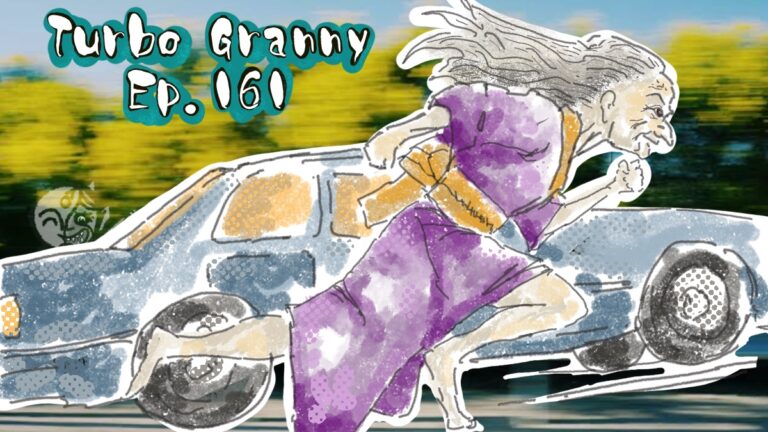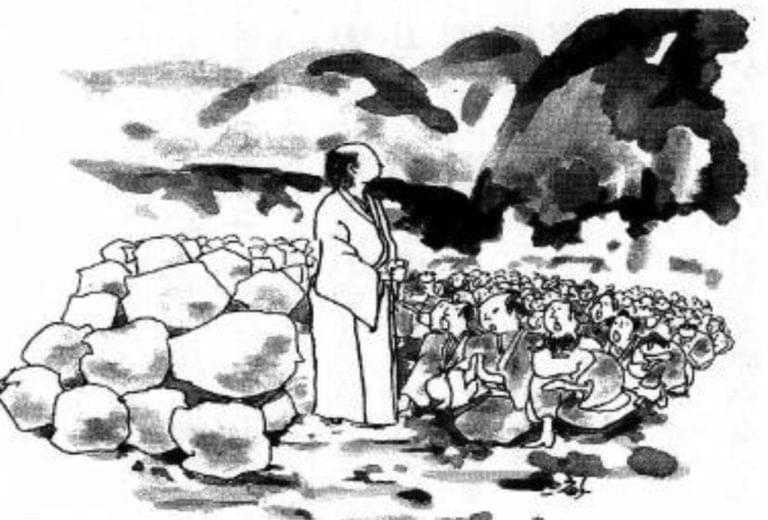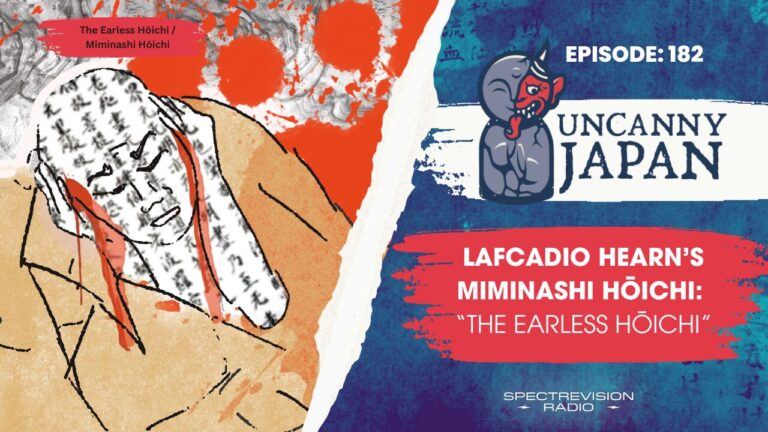I’m Thersa Matsuura and you’re listening to Uncanny Japan.
Intro to the Tale of Anchin and Kiyohime
Imagine this:
In a thunderous roar she bursts through the surface of the water, no longer a weak young woman, but a dragon. Her wet scales sparkle crimson, gold and green as her snake-like body flies at furious speed, undulating toward her prey. She can smell him.
Meanwhile, a monk, handsome, sweating, desperate, presses his forehead against the dirt, bowing and begging the monks of this unfamiliar temple to hide him. They calmly listen to his panicked explanation not sure whether or not to believe such a wild story. Then they hear her in the distance, like thunder fast approaching.
“I have an idea!”
The men race to the temple’s bell tower. Together the monks untie the ropes and lower the large bronze bell over the shivering and terrified runaway. Then they scamper off and hide themselves. Moments later, the dragon crashes through the temple gate and stops. She belches fire from her mouth. She listens. She smells. She’s close. He’s not fleeing anymore.
Podcast Intro
I’m author Thersa Matsuura and this is Uncanny Japan, the podcast about all the delightful, weird and more obscure nooks and crannies of Japanese culture. Today I’m going to tell you the story of dear sweet Kiyohime who was wronged and did something about it. Sure it was a little extreme, but by gosh, it makes for a wonderful folktale.
Real quick, I want to thank everyone for ordering and reviewing The Book of Japanese Folklore by me, Thersa Matsuura, published by Adams Media. And if you haven’t already but want to, I’m both nudging and thanking you in advance. Those reviews help so much in this algorithm-driven world.
The Carp-Faced Boy and Other Tales Audio Book is Out!
The big news though is that the audio version of The Carp-Faced Boy and Other Tales read by me with all the editing and heavy lifting by Rich Pav should be up on all sorts of audio book platforms. Check out your favorite and let me know if it isn’t there. If it IS there, and you want to buy it that would also really help support the show and us. The way it works out, we get a bigger cut of royalties on the audio version that the print one. Anyway, I think it sounds great and was a lot of fun revisiting these stories I wrote almost ten years ago. So arigatou, honto ni.
End intro
Who is Anchin and Kiyohime?
Now, who is this wickedly cool dragon woman and what is she up to? Well, her name is Kiyohime and her folktale — often called “The Legend of Anchin and Kiyohime” (Anchin to Kyohime no Monogatari or Anichin to Kiyohime no Densetsu) — is quite well known in Japan. You’ll find that Kiyohime’s story, much like Hashi Hime’s (Ep. 111) and Oiwa’s (Ep. 42), is one that has been told and retold, twisted and turned and reimagined in many creative ways. It was so popular in Noh and kabuki plays that there are well over a hundred different scripts of this tale, and they had to make a new classification for them called: Dōjōji-mono. Dōjōji is the name of the temple where the climax of the story takes place. There are also bunraku (puppet) plays and songs and lullabies and long scrolls with some gorgeous art depicting Kiyohime and Anchin’s fate. There are trinkets, figurines, netsuke and even festivals also dedicated to Anchin and Kiyohime.
The Original Tale
So today I’ll tell you both the original tale and then a later version, so you can see how it has evolved over time. First off, it looks like the name Kiyohime first showed up in the 18th century (1742) in a play. But before that you’ll find Anchin’s name — he’s the one under the bell. It can be found in the early 1300s. Any stories that mention both Kiyohime and Anchin together come from the Edo Era (1603-1868) or later. So in the very earliest versions there doesn’t seem to be a name for either of the main characters. The story goes something like this.
Once upon a time a young woman came across a handsome monk who was on a pilgrimage. They met. They talked. They promised to meet again. The monk continued on to his destination, a shrine in Kumano on the Kii Peninsula. Only, on his way back he purposely chose a different route so that he wouldn’t meet the woman again. She waited and waited, then realized what he’d done. She was so shocked and hurt, that she closed herself up in her bed chambers and grieved. Her sadness so overwhelming that she died of despair. But that’s not the end of the story. Soon after an enormous serpent emerged from her room and sought out the monk who had so rudely avoided her. She found him at the Dōjō Temple hiding under a large bell and she killed him. But the story still doesn’t end there either. Years later the monk’s ghost appeared to the head abbot of the same temple and begged him to either copy or recite the Lotus Sutra. Doing that would help both free him and the snake woman from their wretched rebirths. The head monk did as asked and it worked. Both the woman and the dead monk were reborn; — into separate heavens, of course. Another rendition says that the two were reborn as two Buddhist deities, Kumano Gongen and Kannon. Which is just about as happy ending as you can get.
After this great nugget of a story, for centuries people retold the legend, being imaginative as well as honing in on some details that make the folktale a lasting one. Here’s the gist of the story you’ll hear more often.
A More Modern Version
Mukashi mukashi, long long ago, there was a very handsome monk named Anchin who every year went on a long walking pilgrimage to visit the Kumano Shrine. Every time he passed through, he’d lodge for one night at the home of Manago (or Masago) Manor. And every time he stayed there he’d chat with the steward’s daughter, Kiyohime. The two got along very well and quickly fell in love. Both looked forward to their meetings. One year Anchin said — perhaps jokingly — that next year he would ask Kiyohime to marry him and she could travel back with him to his home town of Shirakawa, Fukushima, way up north. There they’d spend their life together. Happily ever after. Kiyohime was overjoyed at the idea and very much looking forward to his next visit as well as a life together with charismatic monk.
Only there was no next visit. Whether Anchin realized his mistake in playfully teasing the young woman (never truly intending to marry her) or he changed his mind and decided to focus all his energy on the Buddha’s teachings, we’ll never know. But the next year during the pilgrimage, he did not stop by Kiyohime’s father’s home. The girl was overcome with grief and realizing that she had been lied to, grew furious and set out to find the man who had betrayed her.
She managed to catch up to him on his journey back from Kumano Shrine. But when she confronted him — maybe giving him the benefit of the doubt — , he said, “You have the wrong person and pretended not to know who she was.” As if she couldn’t be shocked by his behavior any more, this really devastated and enraged her. All this affection she’d felt for him and she was sure he’d felt for her, was it a lie? Anchin ran off while Kiyohime stood trying to process what was happening. But she soon gathered herself and took off running after him. As she ran, her upper half turned into a serpent. She reached a river that Anchin had just crossed in a boat. Kiyohime tore off her clothes, completely transforming into a dragon as she did and dove in.
Anchin made it to the Dojo Temple where he pleaded with the monks to hide him. They placed him under the giant temple bell and lowered it over him. But Kiyohime showed up breathing fire and looking for the man who had spurned her. She wrapped herself around the bell, engulfing the whole thing in flames. In some accounts both the bell and Anchin are completely incinerated. In others it more just a melted bell slash human mess. Anchin’s fate remains the same. What happens to Kiyohime? Some say her rage consumed her, too, and she wanders as a vengeful spirit. Some say she ended her own life by drowning on the way back to her home. Some say both her and Anchin were then reborn as snakes until a monk properly prayed and got them off that path.
A New Bell Was Forged
Did I say the story doesn’t end there? It doesn’t. About four hundred years after Anchin was burned along with the temple bell at the Dojoji Temple, in the spring of 1359, they decided to restore the bell. A suitable bell was completed and a dedication ceremony performed. Only it seems like no one learned any lesson from the story at all, because the men performing it ordered that no woman could attend. However, there was at least one shirabyoshi dancer there. Shirabyoshi were entertainers, dancers and singers from the Heian and Kamakura Eras. They dressed as men and were quite popular, especially among the elite. Anyway, this shirabyoshi dancer was actually Kiyohime’s spirit in disguise! After transforming into a giant snake-dragon, she disrupted the ceremony, latched onto the new bell, pulled it down from where it was hanging, and slipped inside, disappearing. Thus possessing it. To which all the monks nervously gathered around and prayed fervently to Kiyohime’s spirit. At some point the bell was again raised. Only from here on out it didn’t sound very good. Also, there continued to be epidemics and all kinds of disasters happening in the area, so the monks took down the bell again and because no one had a good idea, evidently, dragged it into the mountains where they abandoned it.
There’s more. Another 200 years passes and during the great samurai Toyotomi Hideyoshi’s attack on Negoro, the bell was found. Hideyoshi being clever then banged on the bell, using the discordant sound to signal his attacks against the enemy. Eventually though, after the battle he returned to Kyoto with the bell. He knew exactly what bell it was so in order to appease Kiyohime’s spirit he dedicated it to the Myomanji Temple where it still resides today.
A Lesser Known Fact About the Tale
Back to the legend for a minute. You probably can’t help but feel that Kiyohime is the bad guy in the tale. It certainly sounds that way. Some tell the story saying that Kiyohime meets Anchin only once and falls hopelessly in love with the rest of the story being the same. But that one seems a little much to me. If that were the case, it’s cheap and lazy motivation, a crazy woman goes crazy story. I prefer the version where they have known each other over time. That changes the dynamic somewhat. Another little detail that isn’t included much these days but really changes things is that Kiyohime was thirteen years old at the time. A couple places say sixteen. Yes, of course back in the olden times things were different. Life expectancies were much shorter and the age of marriage much younger. Not knowing either parties true intentions makes it more intriguing. Were they both in love? Did Anchin have a change of heart? Was he just joking, not thinking he’d be taken seriously? Did his visit to Kumano reaffirm his devotion to a spiritual path and he just couldn’t bear to see Kiyohime again as he didn’t want to break her heart or his. All of this speculation. Still the ending is fantastically dramatic and wonderful.
The End of the Tale
Let’s see, where did we leave off? Kiyohime infuriated has transformed into a large fire breathing snake dragon and has tracked down Anchin who is cowering under the temple bell. She’s just burst through the temple gate.
With her mane of green hair wild flying about her head, two long horns, and eyes fierce and determined, her body slithers through the air toward the bell. Once there, certain Anchin is inside and she has won, she coils herself around the cool bronze, tightening. She opens her dragon mouth, revealing her fangs, she bites down on the top of the bell and holds on. With her tail she strikes the bell and fire erupts. From her mouth she exhales more fire until the entire bell is engulfed in flames. There she stays latched on, the dragon and bell ablaze for three (some say six) hours. Only then, does she uncoil from the mostly melted bell and leave.
The monks from the temple now reemerge and after waiting for it to cool, tip the giant bell to find a thoroughly scorched and smoldering husk of the handsome monk he once was. As they make plans to bury both him and the ruined bell on the temple grounds, Kiyohime is making her way home shedding tears of blood.
The end.







I see that Mishima has a modern version of the Noh play Doseiji (道成寺) based on the tale of Anchin (安珍) and Kiyohime (清姬). The story is rather like the legend of Phaedra and Hippolytus, best known from Euripides and Racine. Mishima’s novel “Thirst for Love” (愛の渇き) owes something to Racine (its 5 chapters recalling a 5-act tragedy) and to François Mauriac (“Destins” and “Thérèse Desqueyroux”) who was haunted by Racine’s Phèdre. The Phaedra story lives on in “Senso,” a novel of the 1880s by Camillo Boito, elder brother of the opera composer and librettist Arrigo Boito, Luchino Visconti filmed this novel in a smoldering style. The way the aging Italian aristocrat pursues her Austrian soldier, and has him killed when he disowns her, is very like how Kiyohime pursues Anchin.
Joe, this is all very interesting and I’m going to go read up everything you mentioned. It really is a timeless tale that can skew in many different directions, but always fascinating. I am interested in see how other authors and writers approach the topic. Thank you for sharing 🙏